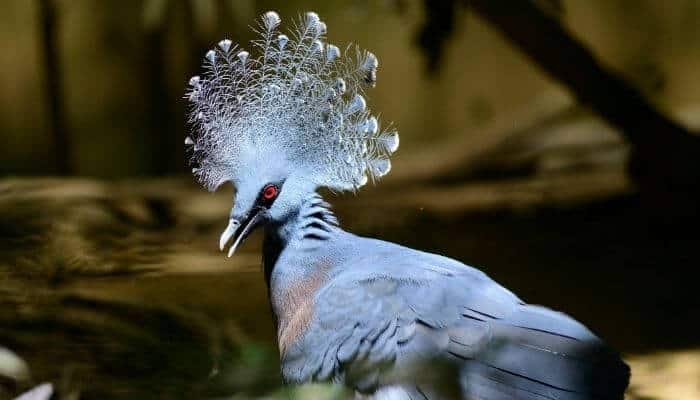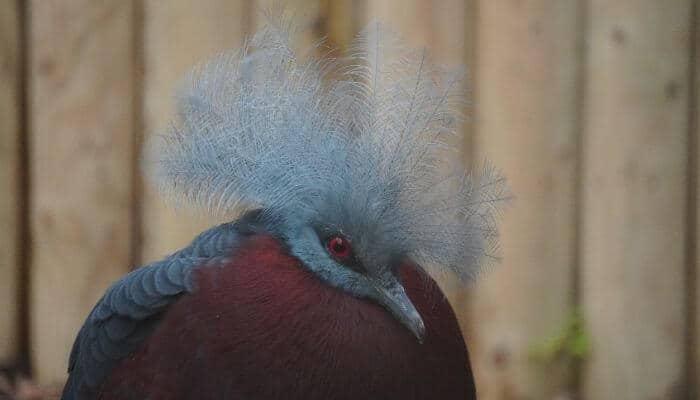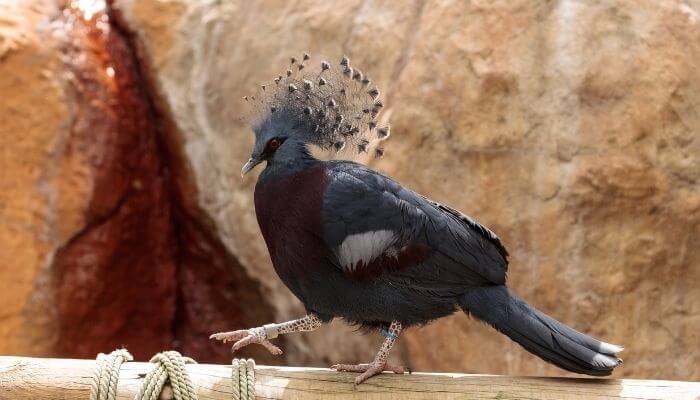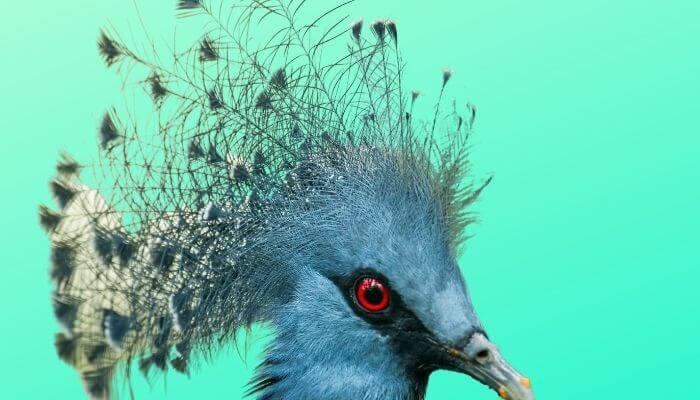The largest species of pigeon, the Victoria Crowned is one of four types of pigeons that are ground dwelling.

It is named after Queen Victoria, likely due to its elegant plumage and bright colours.
Most Victoria crowned pigeons can be found in aviaries or zoos and they aren’t recommended for keeping as pets unless you have the space for them and the knowledge to care for this unique breed.
Victoria Crowned Pigeon Origins
The Victoria crowned pigeon is indigenous to the area known as New Guinea which includes the island groups of Papua and some of Indonesia like the Yapen islands.

The bird typically makes its home in both dry and wet forests and although ground-dwelling and usually at sea level, the Victoria crowned pigeon is known to fly to trees at elevations of up to 3,000 feet.
Historically, the Victoria crowned pigeon has been hunted for its feathers and meat, causing the species to be placed on the protected list due to the risk of extinction.
They are a popular zoo bird to help preserve the species but also because of their striking looks.
It is believed it may be a relative of the sadly extinct Choiseul Pigeon.
Victoria Crowned Pigeon Appearance and Characteristics
This breed of pigeon grows up to 75cm long and to a weight of 3.5 kg.
It is the largest pigeon in the world.
Blue or grey in colour and featuring a small black mask, the Victoria crowned pigeon has wings with a bar formed by a lighter colour and are usually tipped in a maroon colour.
Most of these pigeons also have a deep purple colour on the chest.

The most outstanding feature and that which contributes to its name is the fancy head plumage.
Only two other pigeon breeds are termed “crowned” and they come nowhere near the Victoria in the splendidness of their head plumage.
On the Victoria, the “crown” is an elaborate feather crest that is white on the ends. Due to the colour and the way the tendrils of the crown are splayed, people liken it to a peacock’s open tail.
The crown is present in males and females.
The Victoria has similar characteristics to other crowned pigeons.
When they take flight, they make a loud clapping sound, and their vocalisations are very different to the cooing sound most associated with pigeons.
Their calls can be quite loud and startling to those who have never heard them before.
The mating call sounds like a deep hoota-hoota-hoota-hoota-hoota.
They make a whup-up, whup-up, whup-up sound as a defense call and a muffled deep hmmm is their basic contact call.
Behaviour
One of the most intelligent types of pigeons, the Victoria crowned is easy to tame and has a mild manner and easy-going temperament.
Because they are so docile, they are a star zoo attraction and are often left to roam as they please on the grounds.
Victoria crowned pigeons don’t fly very often but will take flight if they are startled or feel they are in danger.
They might also fly into a roost in a tree at night.

Generally, they will only fly short distances and only if they have to.
Known as one of the more social of pigeons, the Victoria crowned often travels in small groups that look for food together. Their pace is usually slow and steady.
There are occasional brush ups, especially among the males in early mating season or if they feel territorial privileges have been breached but they are usually settled quickly without violence.
The male will puff up his chest, raise his wings and make movements as if he’s going to run at the co-aggressor.
They might make the occasional lunge forward and strike but mainly, shows of dominance are a lukewarm affair and settled without injury.
Diet
Most Victoria crowned pigeons have a diet made up of what they can forage from the ground.
That includes fruit that has fallen from trees, grains, seeds and small invertebrate animals, such as worms.
This type of pigeon is known for particularly enjoying figs.
In captivity, Victoria crowned pigeons eat a seed and grain mix that’s similar to what is offered to other pigeons and doves.

They also need a good mix of fruits and vegetables each day.
This kind of bird doesn’t overeat so uneaten food should be removed each day.
Exercise
Because of their size, this kind of pigeon needs more space to move around than other, smaller species.
They are good at keeping themselves entertained and spend a good part of the day walking in a rather ungainly gait around their area and looking for food.
As mentioned, the Victoria crowned pigeon is a social creature so they shouldn’t live on their own.
They will be more active and happier if they have at least one other pigeon to share their space with.
Victoria Crowned Pigeon Breeding and Reproduction
Like some other kinds of birds, Victoria crowned pigeons often mate for life and males woo the females by bowing and waving their tails.
Females can begin breeding at 15 months of age and generally lay one egg in each clutch and spend about 30 days incubating it before it hatches.

Pigeons feed their babies using crop milk for about 13 weeks, but fledging happens within 4 weeks.
Both the mother and father pigeons play a role in rearing the young.
Threats To The Victoria Crowned Pigeon
The biggest threats to the Victoria crowned pigeon are illegal hunting and destruction of their habitat as many parts of Indonesia and Papua New Guinea continue to be developed.
Because of this, they are on the IUCN Wildlife Red List.
The development of oil palm plantations and logging continue to displace the birds, giving them a category of “Near Threatened.”
The bird had previously been given “Endangered” status but has been downgraded largely due to the decline in hunting of the Victorian crowned pigeon, as well as the measures being taken to protect them.

Capturing this breed of pigeon to keep in captivity is illegal, but still happens from time to time.
Though hunting the birds has declined in recent years, there’s still this threat to the birds.
Current estimates indicate that there are about 10,000 to 20,000 Victoria crowned pigeons in the wild.
Conservation methods are employed in many of the bird’s natural habitats as an effort to preserve their numbers and protect their population.
This includes monitoring hunting activity and trade numbers, as well as employing public awareness campaigns to help protect the species.
As a Red List bird, the world’s zoos are invested in conservation efforts.
Their striking appearance and pleasant nature make them popular and in the UK they can be seen in Edinburgh, Chester, Bristol and Dudley zoos.
They also live at the London Zoo and can be seen in the Lorikeet Lookout on the walkthrough exhibit’s feeding station.
In October of 2020, the Dudley Zoo successfully helped a female Victorian crowned pigeon hatch a baby, adding to the numbers of the birds kept safe in captivity.
